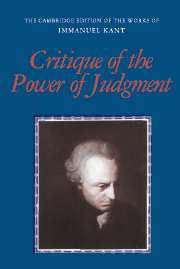Book contents
- Frontmatter
- Contents
- General editors' preface
- Editor's introduction
- First Introduction to the Critique of the Power of Judgment
- Critique of the Power of Judgment
- Preface
- Introduction
- First Part: Critique of the Aesthetic Power of Judgment
- Second Part: Critique of the Teleological Power of Judgment
- First Division: Analytic of the Teleological Power of Judgment
- Second Division: Dialectic of the Teleological Power of Judgment
- Appendix: Methodology of the Teleological Power of Judgment
- Method of citation and abbreviations
- Editorial notes
- Glossary
- Index
First Division: Analytic of the Teleological Power of Judgment
Published online by Cambridge University Press: 05 April 2013
- Frontmatter
- Contents
- General editors' preface
- Editor's introduction
- First Introduction to the Critique of the Power of Judgment
- Critique of the Power of Judgment
- Preface
- Introduction
- First Part: Critique of the Aesthetic Power of Judgment
- Second Part: Critique of the Teleological Power of Judgment
- First Division: Analytic of the Teleological Power of Judgment
- Second Division: Dialectic of the Teleological Power of Judgment
- Appendix: Methodology of the Teleological Power of Judgment
- Method of citation and abbreviations
- Editorial notes
- Glossary
- Index
Summary
On the objective purposiveness which is merely formal, in distinction to that which is material.
All geometrical figures that are drawn in accordance with a principle display a manifold and often admired objective purposiveness, namely that of serviceability for the solution of many problems in accordance with a single principle, and indeed of each of them in infinitely many different ways. The purposiveness here is evidently objective and intellectual, not, however, merely subjective and aesthetic. For it expresses the suitability of the figure for the generation of many shapes aimed at purposes, and is cognized through reason. But the purposiveness still does not make the concept of the object itself possible, i.e., it is not regarded as possible merely with respect to this use.
In such a simple figure as the circle there lies the basis for the solution of a host of problems, for each of which by itself much preparation would be required, and which as it were arises from this figure itself as one of its many splendid properties. If, e.g., the problem is to construct a triangle from a given baseline and the angle opposite to it, then it is indeterminate, i.e., it can be solved in infinitely many ways. But the circle comprehends them all, as the geometrical locus for all triangles that satisfy this condition. Or two lines are supposed to intersect in such a way that the rectangle constructed from the two parts of the one is equal to the rectangle from the two parts of the other: the solution of this problem looks as if it will be very difficult.
- Type
- Chapter
- Information
- Critique of the Power of Judgment , pp. 235 - 256Publisher: Cambridge University PressPrint publication year: 2000



